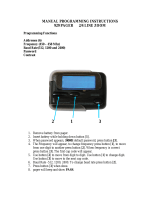
Contents
1. Introducing The DXP Plus ............... ............................................ 1
1.1 Using This Publication.......................................................................................1
1.2 Understanding The DXP Plus...........................................................................2
2. Understanding The Telephone Features........................................3
2.1 Using the Comdial Telephones..........................................................................3
2.2 Understanding The Telephone Features............................................................4
2.3 Using DigiTech Telephones.............................................................................. 6
2.4 Using Impact Telephones.................................................................................. 8
2.5 Using ExecuTech Telephones..........................................................................10
3. Reviewing The Hardware..............................................................12
3.1 Understanding Printed Wire Boards .............................................................. 12
3.2 Defining The Line Boards...............................................................................13
3.3 Defining The Station Boards.......................................................................... 14
3.4 Defining The Optional Circuit Boards.............................................................15
3.5 Locating The Boards...................................................................................... 16
3.6 Using The Modem ...........................................................................................18
3.7 Using The Ring Generator..............................................................................19
3.8 Understanding Board Configuration............................................................... 20
3.9 Mounting Considerations................................................................................ 22
3.10 Using The Power Supply .................................................................................24
3.11 Using The Battery Backup...............................................................................26
4. Connecting The System..................................................................28
4.1 Connecting The Lines .....................................................................................28
4.2 Connecting The Stations.................................................................................30
4.3 Connecting The Paging Equipment And Music Sources.................................32
4.4 Connecting The Power Failure Telephone...................................................... 33
4.5 Connecting The Serial Data Ports....................................................................34
4.6 Connecting The Slave Equipment Requiring Dry-Contact Relay Closures....35
5. Knowing The General Specifications............................................36
5.1 Knowing The FCC Rules And Regulations.................................................... 42
6. Understanding The System Features............................................44
DXP Plus General Description GCA40–130
Contents – iii

























